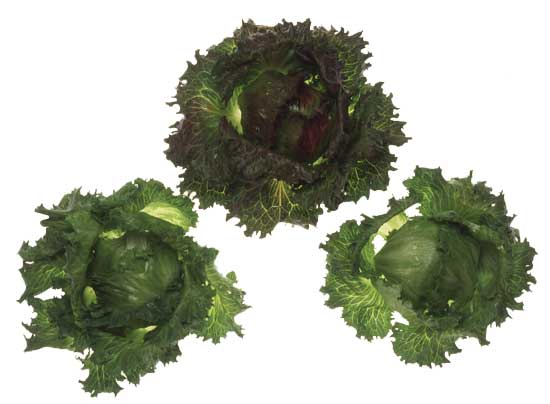Washington, DC
April 13, 2009
Agricultural Research Service, USDA
By
Stephanie Yao
Seven new iceberg lettuce
breeding lines with resistance to bacterial leaf spot (BLS) have
been released by Agricultural
Research Service (ARS) scientists.
BLS, caused by the pathogen
Xanthomonas campestris pv. vitians, is an important disease
of lettuce in California. Iceberg lettuce is the most popular
type of lettuce eaten in America. Nearly all of the lettuce
consumed in the United States is produced domestically. Two
states, California and Arizona, produce more than 90 percent of
the country's commercial lettuce.
Occurring on both leaf and head
lettuce varieties, BLS thrives in wet, cool conditions. It is
most serious in early spring and late fall, when it is most
likely to rain in California. BLS causes black spots to form on
lettuce leaves. These black spots can merge and create papery,
brown-to-black patches on the head. Upon harvest, farmers must
peel and discard the leaves to remove the patches, resulting in
smaller heads that command less money.
BLS is difficult to prevent
because the disease is highly dependent on weather conditions.
Farmers can spray their lettuce crops with pesticides, but the
chemicals have to be applied before symptoms develop, which is
impractical. Because BLS is sporadic and unpredictable, these
preemptive sprayings would be unnecessary in most seasons and
lead to increased production costs. Therefore, according to ARS
geneticist
Ryan Hayes, creating disease-resistant breeding lines is the
most efficient and cost-effective tool to manage BLS in lettuce.
Hayes, along with geneticist
Edward Ryder (now retired) and plant pathologist
Carolee Bull, developed the seven new breeding lines at the
ARS Crop Improvement and Protection Research Unit in
Salinas, Calif. Similar in appearance to the famous ?Salinas'
variety created by Ryder, these lines are the first western
shipping-type icebergs with commercially useful levels of
resistance to BLS. ARS provides these lines to seed companies,
which in turn use them to develop new iceberg varieties for
commercial use.
Limited samples of seed from
these breeding lines are available from the ARS unit in Salinas
to researchers and seed companies.
ARS is the principal
intramural scientific research agency of the
U.S. Department of Agriculture.
|
 |
|
Nearly every head of iceberg lettuce you'll find in
a supermarket owes its parentage to the work of ARS
plant breeders. Salinas iceberg lettuce and its
progeny are the most widely planted iceberg lettuces
in the Salinas Valley of California, the world's
foremost lettuce-growing region. Farmers in other
parts of the United States and foreign countries
from Sweden to Australia also raise these lettuces.
It's amazing what lettuce breeders can accomplish!
Can't eat an entire head of lettuce by yourself?
Never fear-an inventive ARS plant breeder devised an
iceberg mini-lettuce that makes just enough salad
for one person to eat at one sitting.
How do they do it? Lettuce breeders rely on the ARS
gene bank, which houses seeds of more than 2,000
lettuce types. The genes that are banked there today
should result in lots more lettuce-magic soon. Look
for traits like the warm gold of a Hungarian lettuce
or the intense crimson of a Spanish variety to be
introduced into the familiar lettuces that are grown
in the United States today.
Photo by Scott Bauer. |
Siete nuevas líneas de la
lechuga iceberg que tienen resistencia a la mancha foliar
bacteriana (BLS por sus siglas en inglés) han sido lanzadas por
el
Servicio de Investigación Agrícola (ARS).
BLS, la cual es causada por el
patógeno Xanthomonas campestris pv. vitians, es
una enfermedad importante de la lechuga en California. La
lechuga iceberg es el tipo de lechuga más popular en EE.UU. Casi
toda la lechuga consumida en EE.UU. es producida en EE.UU. Dos
estados, California y Arizona, producen más del 90 por ciento de
la lechuga comercial estadounidense.
BLS ocurren en ambas la lechuga
de hoja y la lechuga de cogollo. Esta enfermedad crece bien en
condiciones mojadas y frescas. Es más seria temprano en la
primavera y tarde en el otoño, cuando hay más probabilidad de
lluvia en California. BLS causa manchas negras que se forman en
las hojas de lechuga. Estas manchas negras pueden unirse y crear
manchas más grandes en el cogollo. Durante la cosecha, granjeros
tienen que pelar y desechar las hojas para sacar las manchas
grandes, resultando en cogollos más pequeños que se venden por
menos dinero.
BLS es difícil de prevenir
porque la enfermedad es muy dependiente de las condiciones
climáticas. Granjeros pueden rociar sus cultivos de lechuga con
pesticidas, pero las sustancias químicas se tienen que aplicar
antes de que la lechuga desarrolle los síntomas, lo cual es
impráctico. Ya que BLS es esporádica e imprevisible, estas
aplicaciones preventivas serían innecesarias en la mayoría de
las temporadas de cultivo, llevando a costes aumentados de
producción. Por consiguiente, según genetista
Ryan Hayes con el ARS, crear líneas de crianza que tienen
resistencia a la enfermedad es el enfoque más eficaz y más
económico para controlar BLS en la lechuga.
Hayes, junto con genetista
Edward Ryder (ahora retirado) y patóloga de plantas
Carolee Bull, desarrollaron las siete líneas de lechuga en
la
Unidad de Investigación para el Mejoramiento y la Protección de
Cultivos mantenida por el ARS en Salinas, California.
Semejantes en apariencia a la famosa variedad de lechuga llamada
'Salinas' desarrollada por Ryder, estas nuevas líneas son las
primeras lechugas iceberg del oeste para transporte que tienen
niveles comercialmente útiles de resistencia contra BLS. ARS
provee estas líneas a productores comerciales de semillas, los
cuales por su parte desarrollan nuevas variedades de lechuga
iceberg para el uso comercial.
Muestras limitadas de las
semillas de estas líneas de crianza están disponibles de la
unidad del ARS en Salinas para investigadores y productores
comerciales de semillas.
ARS es la agencia principal
de investigaciones científicas del
Departamento de
Agricultura de EE.UU. |